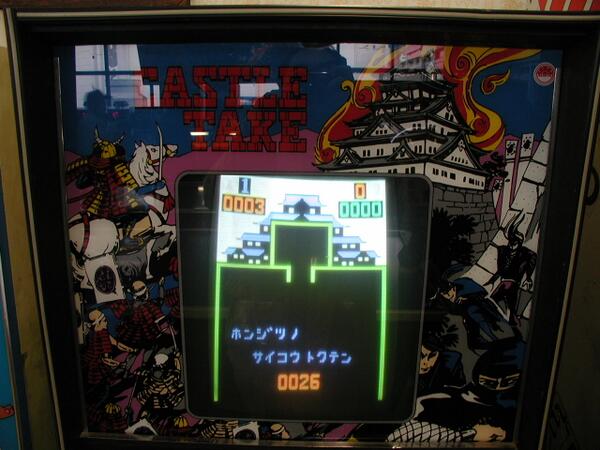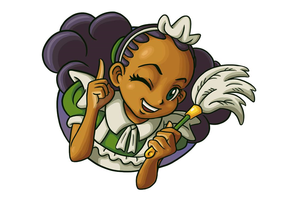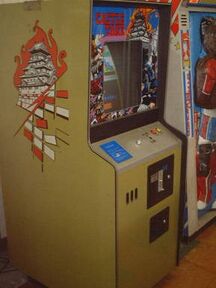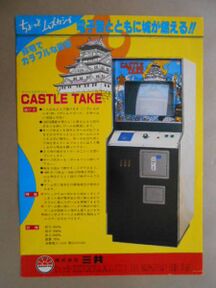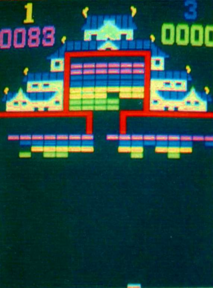Castle Take (lost arcade game; 1978): Difference between revisions
ShadowMan44 (talk | contribs) (First (and probably only) article for this year, I hope this is enough for it to stay up, there was barely anything I could find on this thing but I still kept my hopes up.) |
ShadowMan44 (talk | contribs) mNo edit summary |
||
| (4 intermediate revisions by 3 users not shown) | |||
| Line 1: | Line 1: | ||
{{InfoboxLost | {{InfoboxLost | ||
|image=castletakearcade.jpg | |image=castletakearcade.jpg | ||
|imagecaption=Manual photo taken of the screen, taken by Twitter user @Zenji1. | |imagecaption=Manual photo taken of the screen, taken by Twitter user @Zenji1. | ||
|status=<span style="color:red;">'''Lost'''</span> | |status=<span style="color:red;">'''Lost'''</span> | ||
}} | }} | ||
'''''Castle Take''''' (aka ''キャッスルテイク'', ''Kyassuru teiku'') was an arcade game developed and released in Japan in 1978 by the company "Sankyo". It appears to be a clone of Atari's ''Breakout'', themed around Feudal Japan with the main goal being to take over a Pagoda. Though the game's ROM has not surfaced online yet, there appear to still be playable machines in Japanese arcades. Currently, there is no footage anywhere online, only photos of the screen taken by various Twitter users. | {{NeedingWork}} | ||
'''''Castle Take''''' (aka ''キャッスルテイク'', ''Kyassuru teiku'', ''T.S. Castle Take'') was an arcade game developed and released in Japan in 1978 by the company "Sankyo". It appears to be a clone of Atari's ''Breakout'', themed around Feudal Japan with the main goal being to take over a Pagoda. The game was praised for it's impressive graphics for the time, using a much more advanced graphical chip that could produce more colors than most games made at that time. The game also had both an upright and a cocktail table model. Though the game's ROM has not surfaced online yet, there appear to still be playable machines in Japanese arcades. Currently, there is no footage anywhere online, only photos of the screen taken by various Twitter users. Any magazine articles or reviews of the game are currently unknown. | |||
The company Sankyo later shifted focus to making Pachinko machines, their website documents the history of their Pachinko machines, but nothing regarding any of their block-breaking games. | |||
==Gameplay== | ==Gameplay== | ||
As stated before, this is a game similar to ''Breakout'', with a few gameplay differences to not make it a 1:1 copy. The player must break all the colored blocks in order to progress in the levels, and the blocks at the top are closed off in a more narrow passage (Representing the roof of a Pagoda). | As stated before, this is a game similar to ''Breakout'', with a few gameplay differences to not make it a 1:1 copy. The player must break all the colored blocks in order to progress in the levels, and the blocks at the top are closed off in a more narrow passage (Representing the roof of a Pagoda). Due to the lack of gameplay footage and general information, it is unclear how many levels the game would have had. | ||
==Availability== | |||
There isn't clear estimate of how many units were produced or how common it was in arcades, but because it was popular enough to warrant a sequel be made ''Pyramid'', it can be assumed it was decently popular enough to sell around 1,000 or so units, but not popular enough to have a home release on consoles such as the ''MSX'' or ''Nintendo Famicom''. | |||
==Gallery== | ==Gallery== | ||
| Line 14: | Line 19: | ||
File:Castletakegameplay2.jpg|Screenshot of gameplay. | File:Castletakegameplay2.jpg|Screenshot of gameplay. | ||
File:Castletakecabinet.jpg|Photo of cabinet seen from the side. | File:Castletakecabinet.jpg|Photo of cabinet seen from the side. | ||
File:Castletakeservicemanualcover.jpg|Front cover of the service manual. | |||
File:Castletakeflyer.jpg|Game's flyer. | |||
File:Castletakegameinprogress.png|Screenshot of a level's progression. | |||
</gallery> | </gallery> | ||
| Line 22: | Line 30: | ||
*[https://twitter.com/Zenji1/status/478139121655758848 Source of the header image.] Retrieved 7 Sept '24 | *[https://twitter.com/Zenji1/status/478139121655758848 Source of the header image.] Retrieved 7 Sept '24 | ||
*[https://twitter.com/natuge/status/1035843250265849856 Source of the gameplay screenshot, and the cabinet.] Retrieved 7 Sept '24 | *[https://twitter.com/natuge/status/1035843250265849856 Source of the gameplay screenshot, and the cabinet.] Retrieved 7 Sept '24 | ||
*[https://twitter.com/autobahnjp/status/1686945432403144704 Source of the Service Manual cover] Retrieved 8 Sept '24 | |||
*[https://twitter.com/ZAVIGA84/status/670423475501137920 Source of the flyer] Retrieved 8 Sept '24 | |||
*[https://Twitter.com/Lirsche/status/1379438348691939334 Source of the in-progress screenshot.] Retrieved 8 Sept '24 | |||
==See Also== | ==See Also== | ||
[[Pyramid (lost arcade game; | [[Pyramid (lost arcade game; 1979)]]<br> | ||
[[Tag Play (lost arcade game; 1979)]] | |||
[[Category:Lost video games]] | [[Category:Lost video games]] | ||
[[Category:Completely lost media]] | [[Category:Completely lost media]] | ||
Latest revision as of 05:53, 15 September 2024
Castle Take (aka キャッスルテイク, Kyassuru teiku, T.S. Castle Take) was an arcade game developed and released in Japan in 1978 by the company "Sankyo". It appears to be a clone of Atari's Breakout, themed around Feudal Japan with the main goal being to take over a Pagoda. The game was praised for it's impressive graphics for the time, using a much more advanced graphical chip that could produce more colors than most games made at that time. The game also had both an upright and a cocktail table model. Though the game's ROM has not surfaced online yet, there appear to still be playable machines in Japanese arcades. Currently, there is no footage anywhere online, only photos of the screen taken by various Twitter users. Any magazine articles or reviews of the game are currently unknown.
The company Sankyo later shifted focus to making Pachinko machines, their website documents the history of their Pachinko machines, but nothing regarding any of their block-breaking games.
Gameplay
As stated before, this is a game similar to Breakout, with a few gameplay differences to not make it a 1:1 copy. The player must break all the colored blocks in order to progress in the levels, and the blocks at the top are closed off in a more narrow passage (Representing the roof of a Pagoda). Due to the lack of gameplay footage and general information, it is unclear how many levels the game would have had.
Availability
There isn't clear estimate of how many units were produced or how common it was in arcades, but because it was popular enough to warrant a sequel be made Pyramid, it can be assumed it was decently popular enough to sell around 1,000 or so units, but not popular enough to have a home release on consoles such as the MSX or Nintendo Famicom.
Gallery
External Link
- The only website documenting the game's existence. Retrieved 7 Sept '24
Sources
- Source of the header image. Retrieved 7 Sept '24
- Source of the gameplay screenshot, and the cabinet. Retrieved 7 Sept '24
- Source of the Service Manual cover Retrieved 8 Sept '24
- Source of the flyer Retrieved 8 Sept '24
- Source of the in-progress screenshot. Retrieved 8 Sept '24
See Also
Pyramid (lost arcade game; 1979)
Tag Play (lost arcade game; 1979)
